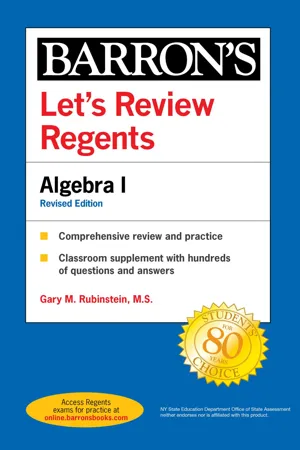Mathematics
Straight Line Graphs
A straight line graph is a graphical representation of a linear equation, where the relationship between two variables forms a straight line. The equation is typically in the form y = mx + c, where m represents the slope of the line and c represents the y-intercept. Straight line graphs are used to visually represent and analyze linear relationships between quantities.
Written by Perlego with AI-assistance
Related key terms
7 Key excerpts on "Straight Line Graphs"
- eBook - ePub
- John Bird(Author)
- 2021(Publication Date)
- Routledge(Publisher)
Chapter 17Straight Line Graphs
Why it is important to understand: Straight Line GraphsGraphs have a wide range of applications in engineering and in physical sciences because of their inherent simplicity. A graph can be used to represent almost any physical situation involving discrete objects and the relationship among them. If two quantities are directly proportional and one is plotted against the other, a straight line is produced. Examples include an applied force on the end of a spring plotted against spring extension, the speed of a flywheel plotted against time, and strain in a wire plotted against stress (Hooke’s law). In engineering, the straight line graph is the most basic graph to draw and evaluate.At the end of this chapter you should be able to:- understand rectangular axes, scales and co-ordinates
- plot given co-ordinates and draw the best straight line graph
- determine the gradient of a straight line graph
- estimate the vertical axis intercept
- state the equation of a straight line graph
- plot Straight Line Graphs involving practical engineering examples
17.1. Introduction to graphs
A graph is a visual representation of information, showing how one quantity varies with another related quantity.We often see graphs in newspapers or in business reports, in travel brochures and government publications. For example, a graph of the share price (in pence) over a 6 month period for a drinks company, Fizzy Pops, is shown in Fig. 17.1 .Generally, we see that the share price increases to a high of 400 p in June, but dips down to around 280 p in August before recovering slightly in September. A graph should convey information more quickly to the reader than if the same information was explained in words.Figure 17.1When this chapter is completed you should be able to draw up a table of values, plot co-ordinates, determine the gradient and state the equation of a straight line graph. Some typical practical examples are included in which straight lines are used. - eBook - ePub
Foundations of Mathematics
Algebra, Geometry, Trigonometry and Calculus
- Philip Brown(Author)
- 2016(Publication Date)
- Mercury Learning and Information(Publisher)
quadrants (first, second, third, and fourth quadrants) that can be labeled as I, II, III, and IV, respectively, in a counterclockwise order, starting with the upper right quadrant.FIGURE 2.2. Points in the Cartesian plane.2.3LINEAR EQUATIONS AND STRAIGHT LINES
Much of mathematics involves the study of related quantities in the form of equations. For this reason, we begin with a study of linear equations and the graphs (infinite straight lines) of linear equations in the Cartesian plane because these quantify the simplest kind of relationship (linear) that related quantities can have. We will refer to an “infinite straight line” (in the Cartesian plane) as a “line.”When a line is drawn in the Cartesian plane, it can be described as a line leaning to the right if the y-coordinates of points on the line increase as the corresponding x-coordinates increase, as a line leaning to the left if the y-coordinates of points on the line decrease as the corresponding x-coordinates increase, or as a horizontal or vertical line (refer to figure 2.3 .). The point where a line crosses the x-axis (if any) is called an x-intercept, and a point where the line crosses the y-axis (if any) is called a y-intercept.There is a relationship between lines in the Cartesian plane and linear equations.DEFINITION 2.3.1. A linear equation is an equation of the form:y = mx + c,(or one of the equivalent forms stated below), where m and c are real numbers and x and y are variables. The variable - eBook - ePub
SAT Prep Book: SAT Secrets Study Guide
Complete Review, Practice Tests, Video Tutorials for the New College Board SAT Exam
- Mometrix College Admissions Test Team(Author)
- 2020(Publication Date)
- Mometrix Test Preparation(Publisher)
First, you may be given a linear equation and asked to select from several choices the graph which corresponds to that equation. Key features such as slope and y -intercept provide clues. Second, you may be given the graph of a linear equation and asked to select from several choices the equation which corresponds with that graph. Note the slant of the line, which indicates the slope, and the line’s intercepts. Third, you may be given a verbal description of a linear graph and be asked to write the equation that matches the given description. Fourth, you may be given a graph of a linear equation and asked to determine key features such as slope (rate) and intercepts. Fifth, you may be given the graph of a linear equation and asked how a change in the equation impacts the graph. For example, you might be asked how a change in the slope or y -intercept affects the slant or position of the line graphed. Helpful Knowledge About Connections Between Algebraic and Graphical Representations Understanding the term slope and the various forms of linear equations, such as slope-intercept form, is very useful. Slope indicates the slant of the line. Lines with positive slopes slant up and to the right. Lines with negative slopes slant down and to the right. A horizontal line has a slope of zero, and the slope of a vertical line is undefined. If a linear equation is written in the slope-intercept form, the slope of the line is given by m. Slope may be determined from a graph as. This often referred to as “rise over run.” Also, the b in the slope-intercept form is the y -intercept of the line. The intercepts are the places where the graphed line crosses the axes. The y -intercept has coordinates (0, b), and the x -intercept has coordinates (a, 0). The two-intercept form of a line is given by where a is the x -intercept and b is the y -intercept. The point-slope form of a line is given by, where m is the slope and (,) is a point on the line - eBook - ePub
Making Sense of Mathematics for Teaching High School
Understanding How to Use Functions
- Edward C. Nolan, Juli K. Dixon, Farhsid Safi, Erhan Selcuk Haciomeroglu(Authors)
- 2016(Publication Date)
- Solution Tree Press(Publisher)
In high school, students extend the work with linear equations and functions to construct functions between two quantities and model real-world situations. When presented with a linear relationship between quantities, students learn to construct an equation in two variables, compute the rate of change between the two variables, and interpret the rate of change in real-world situations. As they explore functional relationships verbally, numerically, graphically, and algebraically, they develop flexibility in translating among these different representations. They define and compare linear and nonlinear relationships, and this enables them to learn to distinguish among real-world situations regarding those that can be modeled with linear functions and those that cannot. Students in grade 8 become familiar with the concept of functions, and concepts such as domain, range, and the inverse of a function are introduced in high school coursework.The MathematicsEquations and functions can be used to model real-world situations and mathematical relationships. High school students must be able to analyze functions with multiple representations and connect the domain and range of a function to its graph. This is best accomplished by using a variety of situations so that students are able to establish meaningful connections among representations and consider reasons for the use of a particular representation.Analyzing Functions With Multiple RepresentationsConsider the task in figure 1.2 . Take a moment to make sense of this task before continuing.Figure 1.2: Perimeter of a rectangle.What equation did you create for the perimeter of the rectangle? Since the length is twice the width, if you use x for the width, the length would be 2x. How do you represent the perimeter of a rectangle? In this case, the perimeter can be represented as x + 2x + x + 2x = 2(x + 2x) = P. This can be simplified to be P = 2(3x) = 6x - eBook - ePub
- Gary M. Rubinstein(Author)
- 2021(Publication Date)
- Barrons Educational Services(Publisher)
5Graphs of Solution Sets of Linear Equations
5.1 Producing a Graph by Identifying Two or More Points
Key Ideas
A linear equation, like x + y = 10, is one where neither of the variables has an exponent greater than or equal to 2. The set of ordered pairs that makes this equation true include (2, 8), (3, 7), and (9, 1). If each ordered pair that satisfies an equation is plotted as a point on the coordinate plane, the result is the graph of the solution set of the equation. For linear equations, the graph is always a line so getting two points in the solution set and drawing the line that passes through those two points will create the graph of the solution set for that line.Graphing the Solution Set of a Linear Equation by Making a Table of Values
The equation x + y = 10 has an infinite number of ordered pairs that satisfy it. One way to organize the information before creating a graph is to make a table of values.This is a chart with three ordered pairs satisfying the equation x + y = 10. For a linear equation, only two ordered pairs are needed, but it is wise to do an extra ordered pair in case one of your first two is incorrect.x y 2 8 3 7 9 1 Plot the ordered pair (2, 8) on the coordinate plane by locating the point that is two units to the right of the y-axis and 8 units above the x-axis. One way to do this is to start at the origin point where the two axes intersect and move to the right two units from there and then up 8 units.Do the same for the other two ordered pairs on the chart (3, 7) and (9, 1).Draw a line through the three points. If the three points do not all lie on the same line, one of your ordered pairs is incorrect.Math Facts
The line on a graph contains an infinite number of points. Each point corresponds to an ordered pair that is part of the solution set for the equation, and each ordered pair that is part of the solution set for the equation corresponds to a point on the line. - eBook - ePub
- Amy Stahl(Author)
- 2021(Publication Date)
- Barrons Educational Services(Publisher)
y-value will always be 2. Then plot the points, and draw the line through the points. This is a horizontal line.x y −2 2 0 2 3 2 Graph x = −1.Make a table, but this time the x-values always stay the same. The x-value has to be −1. Choose three different y-values to help you make the graph. Plot the points, and draw the line. This is a vertical line.x y −1 −2 −1 0 −1 2 CAUTION—Major Mistake Territory!A horizontal line is always written in the form y = b. A vertical line is always written in the form x = a.Examples:y = 3 → Horizontal linex = −2 → Vertical lineSlope of a LineBRAIN TICKLERSSet # 17Graph each line.1.x = 42.x = −23.y = 54.y = −1(Answers are on pages 117 –118 .)Have you ever tried to run up a steep hill? Or ride a bike all the way up a hill without walking? Or ski down a hill? The concept of “steepness” is one that can easily be understood in the real world.Examples of different “slopes” are easy to see. As a beginner skier, which hill would you prefer to ski down? A beginner skier starts on the bunny hill, which is less steep than a hill considered a black diamond!In the world of mathematics, the word slope describes the “steepness” of a line.There are four basic types of slope.
The slope of a line is described as a ratio. It is the comparison of the vertical change in the line compared to the horizontal change in the line. Here is the formal definition of slope.Positive slopeSlants upward, from left to rightNegative slopeSlants downward, from left to rightZero slopeA horizontal line, left to right Has zero slope (like a floor)No slope/Undefined slopeA vertical line, up and down Has undefined slope (like a wall)For a painless way to remember slope, use this saying:•Rise is the vertical distance between points. Rise involves the y- - Craig Adam(Author)
- 2011(Publication Date)
- Wiley(Publisher)
5.2 Linearizing equationsGraphs falling into these last three categories are very powerful tools for the interpretation of experimental data in forensic science. Despite the absence of an adequate theoretical basis on which to build a mathematical model, deriving an empirical formula from experimental data often provides a useful tool for dealing with new problems if appropriate care is taken in its application. Where a model may be deduced from first principles, its validity may be tested quite rigorously using a linear graph. Using the concept of a “best-fit” straight line drawn either by hand or an appropriate software routine, the gradient and intercept of the line may be derived. Once the formula for the model is established it may be used in subsequent work, for example for the prediction of behaviour outside the range of the experimental data. Where the model provides a formula that is not directly expressed as a linear equation, then the formula may be linearized, the graph re-drawn and the model subsequently evaluated. The technique of linearizing equations is an invaluable skill when dealing with graphs in experimental science.The aim in linearizing an equation is to manipulate it algebraically so that it is transformed into the linear form y = mx + c . Recall that the mathematics of the linear graph, including the definitions of m and c , was discussed in section 2.3.1. The variables represented by y and x may be calculated from the experimental data then plotted as the dependent and independent variables to give a straight line. Logically, verification of the linearity of the transformed data may be taken as proof that the data obeys the original equation. This process will be illustrated using example (4) from Section 5.1.The proposed formula, linking field of view FV with magnification M , is:This already bears some resemblance to the standard linear equation with c = 0, but only if x = 1/M and y = FV, i.e. the factor 1/M is the new x -coordinate. Thus, writing it in a slightly modified form shows clearly that with this transformation it is completely equivalent to y = mx
Index pages curate the most relevant extracts from our library of academic textbooks. They’ve been created using an in-house natural language model (NLM), each adding context and meaning to key research topics.






